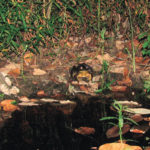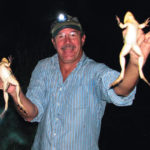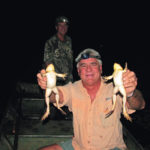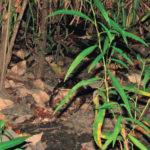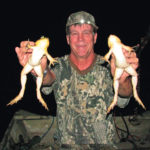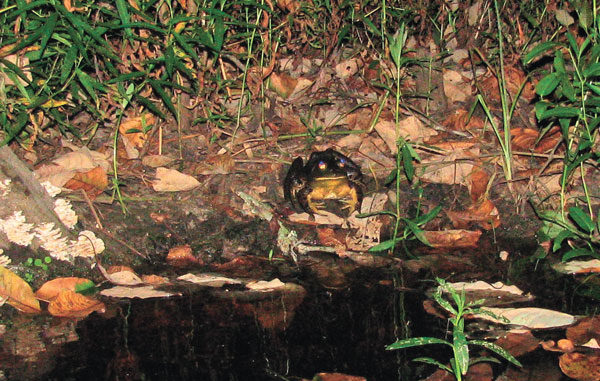
Everyone seems to forget about this popular sport this time of year, but you can’t beat being in the swamp during a cool autumn night.
Before Doc’s brother Clay returned to his exile in Atlanta, the wives decided we’d treat him to dinner — but at a fancy restaurant rather than at the usual raucous dinner party featuring the usual bull-red courtboullion, spawning sow-speck roe fritters and button-buck fajitas.
Our party of 10 required two large tables. As the waiter led us through the crowded restaurant, Clay — as luck would have it — was the first in line, walking right behind “Nigel, our waiter for the evening,” who had already introduced himself in a highly animated and officious manner, while taking time to admire Brenda’s Farah Fawcett hairdo, Clay’s killer bell-bottoms and Pelayo’s polyester collars that flapped like osprey wings as he pranced and tottered on his platform shoes.
Nothing like a disco party to honor Clay, the former prince of Fat City.
And after scrounging up and somehow making the outfits fit-able, it seemed unfitting to change for the late dinner, regardless (or especially because) of the restaurant’s elegant cachet.
“Are these commie frog legs?” Clay pointed at the menu after we were seated.
Nigel, our “waiter for the evening” seemed baffled.
“I beg your pardon?” our waiter smiled while nervously scurrying toward Clay, who had partaken generously of the pre-dinner happy hour earlier at Chris and Cindy’s place.
“I mean, where do these frogs come from?” insisted the florid-faced Clay.
“Well, I’m not — I’m not quite sure… but I can certainly…”
“I mean, come ON!” Clay said while glaring around the table, then up at the flustered Nigel. “This menu seems specific on all the OTHER items, right? Like fresh GULF shrimp, and fresh GULF tuna and LOUISIANA oysters, right?”
“Well, yes, yes,” stuttered Nigel. “Of course, we’re very, very proud …”
“So why NO boasting about the origin of the frog legs?” Clay snarled.
“Um … well … sir … I’m not really certain. But I can certainly find …”
“You know GOOD and WELL WHY!” Clay said as half the heads in the place turned toward him.
His wife Brenda jumped to her feet, threw her napkin in his face and clomped off in her platform shoes, her hoop earrings jangling and disco dress billowing.
“They’re probably from Viet Nam! That’s WHY! Many places are importing frogs from those COMMIES nowadays!”
“Well … well … I’m not sure.”
“Then find OUT!” Clay said, at a volume that had the girls tugging his arms and the patrons at neighboring tables looking over.
Nigel, “our waiter for the evening” scurried off but quickly returned and leveled with us.
“Andre, the chef, says they’re from China — but of a very high quality and with thorough inspection by …”
“Almost as bad!” Clay said as Cindy gripped his arm trying to quiet him. “Good thing my Uncle Gus ain’t here!”
Clay continued, but at a slightly lower decibel level.
“He was a Marine in Korea — Chosin Reservoir. He’s a proud member of the Chosin Few. But OK, OK thanks for the info, Nigel. Where the frogs come from ain’t your fault. I know.”
A large gulp of wine seemed to have a calming effect on Clay.
Clay is still ultra-sensitive to issues Southeast-Asian. The Deer Hunter is STILL his favorite movie. “One shot!” he still smirks on duck hunts, after we empty our chambers at frantically departing teal. Clay usually folds one on his first shot, like De Niro dropped that European Red Stag with his. (How a European Red Stag got into Pennsylvania’s Allegheny Mountains was not explained in the movie, however.)
During The Deer Hunter’s Russian Roulette scene, Clay was coiled like a spring in his seat at the Robert E. Lee Theater.
“Mau!”— the commie slapped De Niro and Clay jerked in his seat, clenching his fists around what he thought was the armrest but instead was my arm.
When De Niro asked for “THREE” bullets, “we do THREE!” while holding them up “ONE, TWO, THREE,” Clay looked around at Pelayo, Chris and me wide-eyed and gaping.
Then the commie slaps him again, and the enraged De Niro grabs him by the collar: “Oh — you GONNA DIE!” he snarls. “You GONNA DIE!” Here Clay flinches and seems to lunge for the commie on the screen.
Then De Niro finally puts the gun to his head, growls, “Grrrrrrr!” hits the trigger — “CLICK!” and starts laughing. Here Clay himself starts laughing, but nervously while looking around, and still gripping my arm like the bite of a snapping turtle.
De Niro — as we know — was laughing for good reason. In a snap-second he turns the pistol on his captors — “BLAM!” — right in the forehead, and the commie crumples like a neck-shot button-buck. The other commies freak at this turn of events. They’re too slow on the draw. So De Niro and his quick-acting buddies snatch the AKs from their grip, and turn the tables, mowing ‘em down like a litter of suckling pigs around Pelayo’s corn feeder — but without all the squealing.
At this point in the movie, Clay — like a snapping turtle with a lighter to his butt — finally released my arm and leaped from his seat, waving his fists and whooping crazily, but spilling the Dixie quart he’d snuck past the usher and hidden under the seat. Careful rationing of Pelayo and Chris saw us through the rest of the movie.
“Don’t worry, Clay,” Pelayo leaned over and hissed in his ear. “Before you go back, we’ll get ya some non-commie frog legs. I ga-ron-tee.”
If there’s something more enchanting than a South Louisiana swamp panorama, it’s a South Louisiana swamp panorama at night. But this enchantment mostly comes from knowing you can escape the sweltering, stinking, bug-filled place on a second’s notice and scurry back to a La-Z-Boy in an air-conditioned den to sip a toddy prepared and delivered by your sexy, affectionate and obedient wife — then lean back to watch Swamp People.
Which we could. But the beauty of October frogging, after the first few fronts of the year, is the lack of craving for such relief and succor.
The first scan of the Q-beam along the Maurepas swamp bayou found dozens of eyes glowing back.
“Wow! Look at them all!” Clay whooped. “Won’t take us long to load the sack tonight!”
“That’s mostly gators,” Pelayo admonished Clay as he pointed toward some big glowing eyes. “You know, that endangered species — whoops! Sorry. My mistake! Actually the feds have finally moved alligators from endangered to merely a threatened species.”
“They look about as endangered as red snapper to me,” said Clay, while turning and again blinding Pelayo with the light. (Clay had sampled some offshore fishing on this Louisiana visit.)
And “that’s a nutria,” Chris corrected as Clay pointed at some others on the opposite bank. “Frog eyes glow green. The other critters glow pink or red. The little green ones belong to little frogs and spiders. So there. Now you’re ready.”
“Lousy place y’all picked. I don’t hear any bullfrogs,” said Clay as we eased deeper into the swamp.
“Bullfrogs don’t do much croaking in the fall, Clay,” Pelayo explained. “They’re not mating much now.”
“I see,” he nodded. “The stuff one learns in you guys’ company. Simply amazing. Ah, I just heard one!” Clay brightened.
“That was a pig frog,” Chris corrected again. “Not a bull. How quickly you forget. First the eyes. Now the grunts.
“Quickly?” Clay huffed. “Geezum! Last time I went frogging I think we went straight to the Bonnet Carre spillway from Kenny Vincent’s Southside!”
“Think it was from 4141,” added Chris.
“And to Bully’s Halfway House afterwards,” Pelayo reminded us, “when Budweiser longnecks were its signature dish.”
For whatever reason, the frogs in this area like hanging near the bottom of the wax myrtles and bachiris bushes that overhang the water, which made the 12 foot gig indispensible for “harvesting” at least half of them. Kinda like deer, bullfrogs seem to thrive best in areas with abundant understory. I don’t mean greenbriar, blackberry, honeysuckle, gallberry, etc. I mean alligator grass, smartweed, duck potato, iris, peavine, etc. For whatever reason, bayou banks with a closed canopy of trees overhead and sparse weeds near the bank harbor much fewer frogs than more open ones that allow the sun to penetrate and the undergrowth to flourish.
Alas, high — and even normal — tides that flood this undergrowth help hide the frogs. Hence our preference for frogging on low tides after northwest winds when the delectable creatures emerge from the flooded brush and perch on the exposed mudbank. In brief, our favorite frogging locales and conditions can be easily defined as: bayous, ponds and canal banks with heavy shoreline brush — but during low tides. Hence our pick of the upper Maurepas swamp for this venture, between Ruddock and Manchac with its open canopy of dead and studded cypress and thick understory.
In general, pig frogs are more common in the fresh, open (especially flotant) swamps near coastal Louisiana. They don’t get as big as bullfrogs, but the larger ones are still worth nabbing, gigging or netting — take your pick. Being that they’re generally in the open marshes, they’re easy to grab by hand, as their position generally allows an open approach from an airboat, surface drive craft, pirogue, even — dare I say it? — kayak!
There, I said it. But something tells me that your typical kayaker won’t readily take to frogging. Unless he can find a designer headlamp and release his catch. But in the middle of a swamp at night, who’s around to watch him release it? Who can he turn to for applause? Who will thrill to his smug little grin upon his environmentally and politically-correct beneficence? Who will hear his lecture regarding “giving something back” to the wondrous earth goddess Gaia?
Whatever. Many frogging purists frown on using gigs. Most of these frowners frog in areas swarming with bullfrogs, like the Atchafalaya Basin, rice fields, flotant marshes, open weed-studded ponds, etc. Here you can airboat or Go-Devil right up to dozens of them that provide easy pickings by hand from the front of the boat.
Alas, the matter becomes more complicated in areas like — say — the Pearl River Basin or Maurepas Swamp, with fewer frogs and where trees and brush along the bank preclude easy access to frogs that are often squatting among cypress knees and/or mazes of bachiris, dogwood, willow and wax myrtle trunks and branches. In this type of terrain, a gig on the end of a 12-foot pole can easily double or triple your catch. So those with an actual craving for fresh non-commie frog legs (us) always bring along a gig, at least for back-up.
An early Pacific front cooled things down a few degrees — but more importantly, that west to northwest wind dropped tides to near-perfect frogging range. A high tide scatters frogs throughout the interior of the swamp and amidst the alligator grass, smartweed, etc. A low tide brings them out to the bank. A nice foot or two of mud bank from the brushline to the water is perfect. The frogs perch on it, making for easy sighting and easy pickings.
Except when you spook ‘em.
“Told you to keep the light on it!” Pelayo snarled at Clay. “Once you got it in the beam — DON’T move it! Moving it away — then back, often spooks them. Heck, sometimes just a shadow moving in front of the beam spooks them, especially late in the season like this.”
If too many cooks spoil the broth, then too many lights spoil the frogging trip. And we had four people on board with three lights.
“Turn it OFF!” Pelayo screamed at Clay from back. “Every time you turn around, I’m blinded by the light!”
“Revved up like a deuce, another runner in the light,” Clay added without missing a beat. “You do a great Manfred Mann,” he said while turning around and blinding him again.
“I’m doing Bruce Springsteen, if you must know,” deadpanned Pelayo. “He wrote the song and had a hit with it four years before Manfred Mann.”
A pig frog’s green eyes and white chin glowed up ahead. He was sitting half submerged in a bed of floating alligator grass.
“Won’t need a gig for this one,” Pelayo said as he idled toward the prey.
Then Pelayo let off the throttle … let the boat drift … drift … drift. Chris was poised on the bow — WHAM! He reached down and grabbed the sucker by hand. In seconds, the frog was hopping crazily in the wire basket.
“Here comes Amos!” whooped Pelayo. “Had no idea Amos Moses himself as frogging with us tonight!”
In fact, we were about “45 minutes northeast of Ti-Ba-Doe, Loo-ziana.” So Pelayo had a point. Jerry Reed’s classic (for us) Amos Moses sure hit the spot at the moment.
“Whoops!” Pelayo pointed ahead. “Now THAT one ain’t no pig frog!”
“No way!” I whistled when the Q-beam hit him again.
It was a nice bullfrog, but a bit obscured by branches. Time for the gig. We idled in, and I started extending the gig towards my prey — but — bump — the gig hit a branch while en route. The big frog hopped off. But back into shoreline brush, rather than forward into the bayou.
“Nice!” Pelayo snarled sarcastically. “Shoulda let Amos do the honors!”
“It ain’t over yet,” I said stepping off the front of the boat onto the shore. “I’m wearing these hip boots for a reason.”
Scanning with my headlamp, I spotted my prey bout 10 feet into the alligator grass. Nothing to block my spearing this time, and I easily gigged him.
Scanning and gigging the next 200 yards of bayou bank yielded us three more frogs, one pig and two bulls. Then we turned into a shallow slough and eyes glowed ahead — but these were mostly green!
“Whoo-boy!” yelled Chris. “Now slow down.”
He grabbed the first two, and I gigged the next three and the evening’s enchantment cranked up a few notches.
We ended up with 15 frogs — nine pigs and six bulls. Nothing by Atchafalaya Basin standards, but plenty by ours. And Clay’s smile was the widest of all. None of these, after all, were commie frogs.
